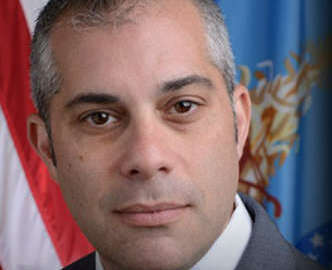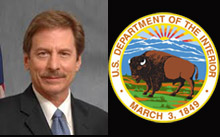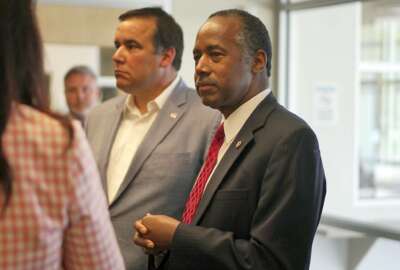 Exclusive
Exclusive Agency CIOs in the eye of brewing reorg storm
The reorganization plans of three agencies show a trend of consolidating, centralizing back-office functions.
If the departments of State, Agriculture and Housing and Urban Development are any indication, federal technology offices are in store for major shakeups over the next year.
And for many, that may not be such as bad thing.
Details of all three agencies’ Trump administration-mandated reform plans began to come out over the last few weeks, and while the planned changes are broad in scope, the trend is clear: reduce the back-office duplication in terms of both people and services, and centralize the oversight.
Let’s start with USDA, whose Secretary Sonny Perdue has been in front of the message by offering details before they leak out — of course, the same can’t be said for the other two agencies, but we will get to them in a minute.
On Sept. 7, Perdue announced in a video and through a press release initial changes he plans to institute at USDA.
“In the four months that I’ve been secretary, we’ve been examining our offices and our processes, looking for ways we can provide better services to our customers,” Perdue said in the video. “We are announcing further steps that will make sense for our mission at USDA and will help you do your jobs better, so it’s a win-win for the people of American agriculture. And again, as with the reorganization we announced in May, I intend to handle any staff changes through normal attrition or reassignment.”
USDA stated all of these restructuring efforts are focused on a few simple areas: To improve customer service and maximize efficiency, and involve innovation, consolidation and the rearrangement of certain offices into more logical organizational reporting structures.
The agency’s assorted technology and chief information officers will be at the front of this restructuring train.
Perdue said USDA has 22 CIOs throughout the headquarters and component agencies, which creates redundancies when it comes to IT activities and services, and too many layers of leadership and direction.
“[M]ission support activities will be merged at the mission area level across USDA,” Perdue wrote in a release to staff and the public. “Through these mergers, the mission areas will not only increase operational efficiencies, but also maximize collaboration between agencies that serve similar customers. This has happened in many of the support activities in mission areas already and is working well.”
Additionally, Perdue said this effort also will help reduce the number of redundant administrative functions around human resources, finance and procurement.
More acting IT execs at USDA
Details about what all this really means are unclear. Multiple emails to USDA seeking more specifics were not returned, and sources inside USDA said they haven’t been told what the consolidation will end up looking like, or the timing.
Additionally, the CIO consolidation effort is happening without a permanent CIO. In fact, USDA named two more executives to take over acting roles. Francisco Salguero now is the acting deputy CIO and Frank Hoeppel is acting associate CIO for client technology services.
But former USDA IT executives say on the surface, Perdue’s ideas make sense and have been a long time coming.
“I think what the secretary is looking at is how best to add speed to execution on the IT side,” said Joyce Hunter, a former deputy CIO for policy and planning at USDA, and now CEO of Vulcan Enterprises LLC, an IT consulting and strategic management firm. “When you have CIOs that are divided in action and execution because their performance plan is being done by the component’s administrator, their loyalty is to that administrator. So when the headquarters CIO comes down and says do this, and the administrator doesn’t agree, there is friction. I think the secretary understands the mission and knows USDA has to start moving faster for IT modernization.”
Hunter said that friction happened often during her four years with the agency.
“Headquarters’ direction was not always accepted or followed fast enough and we would have meetings with the administrator and the component CIO,” she said. “We would discuss the item during the USDA CIO Council meetings. It all depends on the administrator, who sometimes accepted the direction and sometimes didn’t.”
A recent example of this challenge came during the implementation of the Federal IT Acquisition Reform Act (FITARA). Hunter and Flip Anderson, the FITARA operations officer, went to each component CIO and to the agency CIO Council to outline the expectations and changes.
“Some were very responsive, and others just said they will get to it when they get to it,” Hunter said. “There was no stick. But taking away the title of CIO could solve some of those problems, because then when the departmental CIO makes a decision, the other components will know it’s a high priority of the secretary.”
Don’t get hung up on titles
USDA officials briefed lawmakers about their reform plans.
Rep. Mike Conaway (R-Texas), chairman of the Agriculture Committee, said in an email that he supports the reorganization plans.
“While folks will have an opportunity to comment on the reorganization, I see tremendous value in having all of the farmer-facing agencies under the same umbrella, even if they are implementing different programs,” he said.
Bob Suda, a former USDA executive and now a consultant, said when he was there in the mid-2000s, there were a lot of shadow IT organizations and the cost of administrative functions was higher than it needed to be.
“The first step is to reduce titles. I know people love titles, but it’s about getting the job done,” Suda said. “It’s also about infrastructure versus application. A majority of the infrastructure should be done by the headquarters CIO’s office, and the mission apps should be done by mission-area CIOs. Too often the mission-area CIOs are doing both.”
Suda said especially with the move to the cloud, the infrastructure becomes more centralized and less complex, so the focus for component CIOs should be almost solely on the mission.
The most recent example of a similar consolidation of CIOs happened in 2010 at the Interior Department. Among the changes at Interior were all the bureau-level CIOs became assistant directors for information resources (ADIR), and the headquarters CIO began consolidating commodity IT services, including reducing 14 email systems to one.
Suda also pointed to a similar effort in the 1980s at the General Services Administration with its financial operations. He said 11 offices around the country were consolidated into two.
“No one lost their jobs and most found other opportunities in other parts of GSA, and most got better jobs,” he said. “It takes time to do this type of consolidation. It can’t happen overnight. It’s a one-to-two-year effort.”
State to move to the cloud
Over at the State Department, the details are even less clear. But Secretary Rex Tillerson sent out an internal update to staff, highlighting expected changes.
“[W]e know a priority for us is to modernize an outdated IT system, so we’re taking major steps toward putting our systems on the cloud,” Tillerson wrote in the email, which Federal News Radio obtained. “We know you have families, so we’re also exploring options for flexible work programs. In addition, Eligible Family Members are an important part of supporting efficient delivery on our mission, so we’re making provisions in some cases to increase the level of EFMs. Our working groups have also identified areas where we can improve our human resource functions, empower leadership at all levels, and improve management support services to reduce redundancies while ensuring you have the tools you need to do your job.”
State’s reform plan also aims to align the agency with the U.S. Agency for International Development (USAID) more closely, specifically around foreign assistance and foreign policy and capabilities.
“It includes seven ambitious proposals with investments that will generate a minimum deliverable of 10 percent ($5 billion) in efficiencies relative to current (fiscal 2017) spending over the next five years, with an aspirational general interest target of up to 20 percent ($10 billion),” the email stated. “These efficiencies enabled by modernized systems and work processes will adjust the current historically high spending level by reducing duplications and unnecessary overhead for State, USAID, and other agencies. Adopting these recommendations that you expressed your hope for in the listening sessions will allow us to better focus on our core policy priorities and programs. It will also lay the groundwork for additional efficiencies and improvements in later years.”
These changes come from a steering committee of foreign and civil service leaders from both State and USAID that Tillerson set up in July.
This group sought to gather the ideas to improve their respective organizations.
The steering committee oversees working groups for five different areas in State and USAID aims to better structure their processes.
The five working groups are:
- Foreign assistance
- Overseas alignment and approach
- Human capital planning
- Management support
- IT platform planning
“In the weeks ahead, we will continue to develop and advance other recommendations. Some will require congressional approval or a change in law, some will require OMB support, but there are a number of actions we can begin to undertake internally,” Tillerson wrote in the most recent email. “Some examples that we’ve already started on include integrating certain Special Envoy offices into the bureau structures and efforts to increase diversity in our workforce. You should expect to see results unveiled on a rolling basis. Once a solution is ready to go, we are going to put it to work as soon as we can. We will continue to ask for input and consult with you and other stakeholders — including Congress — as we move forward.”
Repeated emails to State asking for more details on the IT changes were not returned.
HUD town hall on Sept. 20
Over at HUD, officials are planning a reform plan rollout on Sept. 20.
The draft reform plan from June, which some sources say likely hasn’t changed a great deal, highlights the need to reconsider its shared services for human resources from Treasury’s Bureau of Fiscal Service, as well as consider a new offering from GSA called the Federal Enterprise Business Center, which would deliver common and transactional administrative functions and technology for all civilian agencies.
Additionally, HUD’s draft plan called for the agency to modernize its IT infrastructure using the cloud, digital services and other popular buzzwords to improve accessibility, performance and convenience.
Return to the Reporter’s Notebook
Copyright © 2025 Federal News Network. All rights reserved. This website is not intended for users located within the European Economic Area.
Jason Miller is executive editor of Federal News Network and directs news coverage on the people, policy and programs of the federal government.
Follow @jmillerWFED






